University Report: Change Management Strategies for Cathay Pacific
VerifiedAdded on 2022/09/01
|20
|5115
|34
Report
AI Summary
This report offers a comprehensive analysis of change management strategies for Cathay Pacific Airways Limited, focusing on the airline's internal and external business environments. The report begins with an overview of the company and its mission, followed by a detailed PESTEL analysis to evaluate political, economic, social, technological, environmental, and legal factors influencing its operations. A SWOT analysis identifies the company's strengths, weaknesses, opportunities, and threats, while Porter's Five Forces analysis assesses the competitive landscape. Force Field Analysis is used to examine the driving and resisting forces of change, and the report concludes by applying Lewin's Change Management Model to outline a three-step change implementation process. The report also includes a discussion on how to mitigate potential negative impacts of change on organizational behavior.

Running head: CHANGE MANAGEMENT
CHANGE MANAGEMENT
Name of the student
Name of the University
Author note
CHANGE MANAGEMENT
Name of the student
Name of the University
Author note
Paraphrase This Document
Need a fresh take? Get an instant paraphrase of this document with our AI Paraphraser
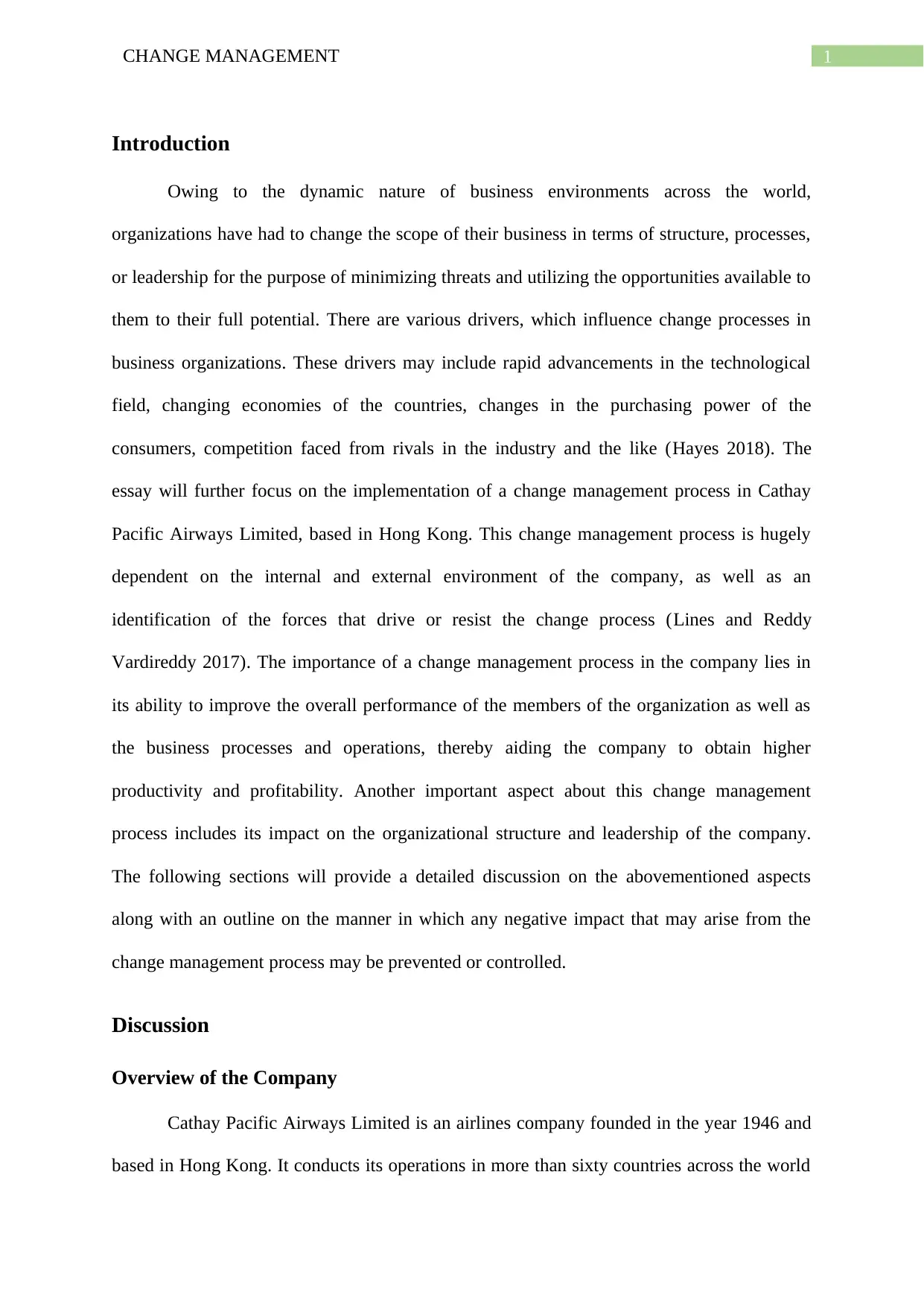
1CHANGE MANAGEMENT
Introduction
Owing to the dynamic nature of business environments across the world,
organizations have had to change the scope of their business in terms of structure, processes,
or leadership for the purpose of minimizing threats and utilizing the opportunities available to
them to their full potential. There are various drivers, which influence change processes in
business organizations. These drivers may include rapid advancements in the technological
field, changing economies of the countries, changes in the purchasing power of the
consumers, competition faced from rivals in the industry and the like (Hayes 2018). The
essay will further focus on the implementation of a change management process in Cathay
Pacific Airways Limited, based in Hong Kong. This change management process is hugely
dependent on the internal and external environment of the company, as well as an
identification of the forces that drive or resist the change process (Lines and Reddy
Vardireddy 2017). The importance of a change management process in the company lies in
its ability to improve the overall performance of the members of the organization as well as
the business processes and operations, thereby aiding the company to obtain higher
productivity and profitability. Another important aspect about this change management
process includes its impact on the organizational structure and leadership of the company.
The following sections will provide a detailed discussion on the abovementioned aspects
along with an outline on the manner in which any negative impact that may arise from the
change management process may be prevented or controlled.
Discussion
Overview of the Company
Cathay Pacific Airways Limited is an airlines company founded in the year 1946 and
based in Hong Kong. It conducts its operations in more than sixty countries across the world
Introduction
Owing to the dynamic nature of business environments across the world,
organizations have had to change the scope of their business in terms of structure, processes,
or leadership for the purpose of minimizing threats and utilizing the opportunities available to
them to their full potential. There are various drivers, which influence change processes in
business organizations. These drivers may include rapid advancements in the technological
field, changing economies of the countries, changes in the purchasing power of the
consumers, competition faced from rivals in the industry and the like (Hayes 2018). The
essay will further focus on the implementation of a change management process in Cathay
Pacific Airways Limited, based in Hong Kong. This change management process is hugely
dependent on the internal and external environment of the company, as well as an
identification of the forces that drive or resist the change process (Lines and Reddy
Vardireddy 2017). The importance of a change management process in the company lies in
its ability to improve the overall performance of the members of the organization as well as
the business processes and operations, thereby aiding the company to obtain higher
productivity and profitability. Another important aspect about this change management
process includes its impact on the organizational structure and leadership of the company.
The following sections will provide a detailed discussion on the abovementioned aspects
along with an outline on the manner in which any negative impact that may arise from the
change management process may be prevented or controlled.
Discussion
Overview of the Company
Cathay Pacific Airways Limited is an airlines company founded in the year 1946 and
based in Hong Kong. It conducts its operations in more than sixty countries across the world
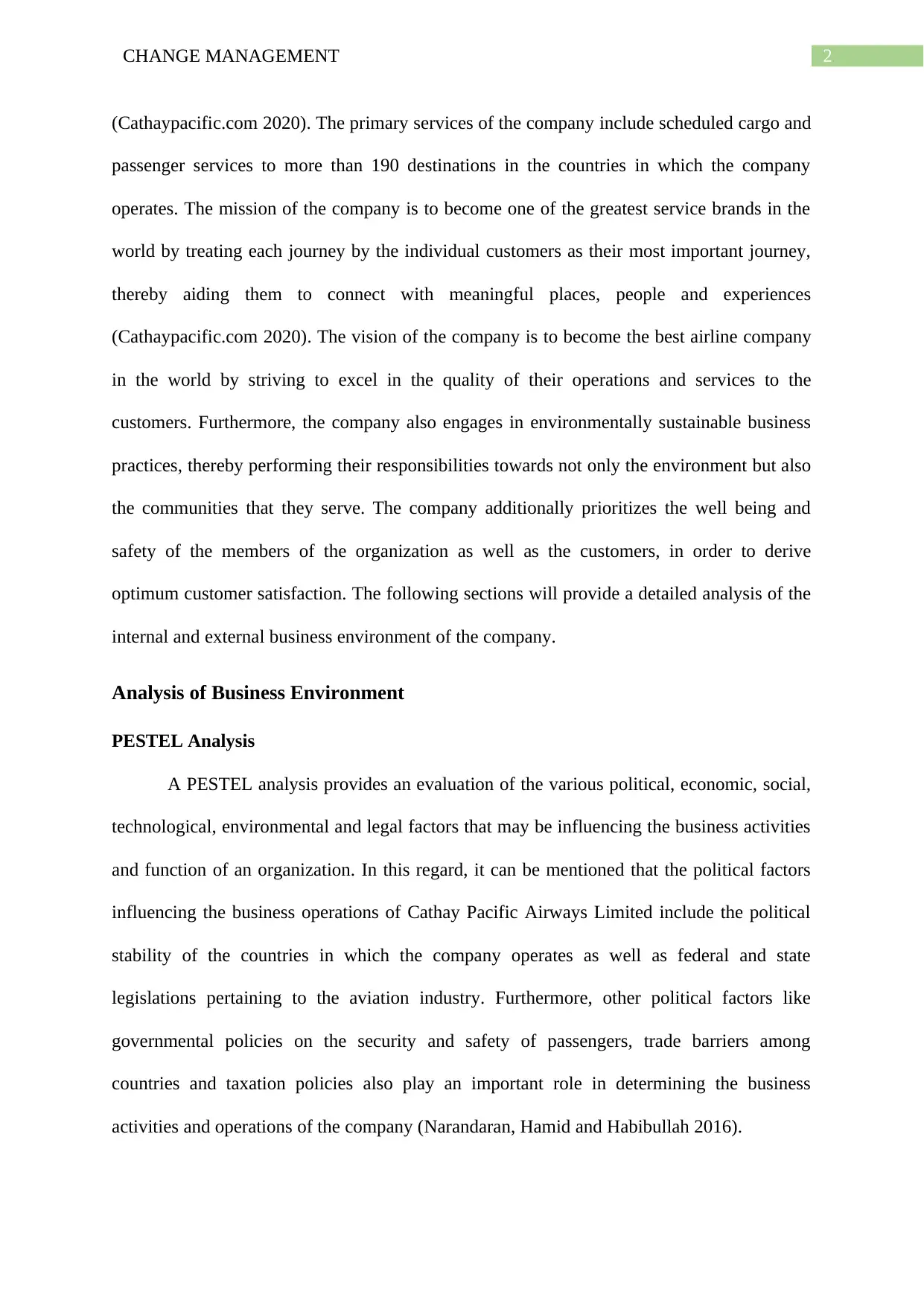
2CHANGE MANAGEMENT
(Cathaypacific.com 2020). The primary services of the company include scheduled cargo and
passenger services to more than 190 destinations in the countries in which the company
operates. The mission of the company is to become one of the greatest service brands in the
world by treating each journey by the individual customers as their most important journey,
thereby aiding them to connect with meaningful places, people and experiences
(Cathaypacific.com 2020). The vision of the company is to become the best airline company
in the world by striving to excel in the quality of their operations and services to the
customers. Furthermore, the company also engages in environmentally sustainable business
practices, thereby performing their responsibilities towards not only the environment but also
the communities that they serve. The company additionally prioritizes the well being and
safety of the members of the organization as well as the customers, in order to derive
optimum customer satisfaction. The following sections will provide a detailed analysis of the
internal and external business environment of the company.
Analysis of Business Environment
PESTEL Analysis
A PESTEL analysis provides an evaluation of the various political, economic, social,
technological, environmental and legal factors that may be influencing the business activities
and function of an organization. In this regard, it can be mentioned that the political factors
influencing the business operations of Cathay Pacific Airways Limited include the political
stability of the countries in which the company operates as well as federal and state
legislations pertaining to the aviation industry. Furthermore, other political factors like
governmental policies on the security and safety of passengers, trade barriers among
countries and taxation policies also play an important role in determining the business
activities and operations of the company (Narandaran, Hamid and Habibullah 2016).
(Cathaypacific.com 2020). The primary services of the company include scheduled cargo and
passenger services to more than 190 destinations in the countries in which the company
operates. The mission of the company is to become one of the greatest service brands in the
world by treating each journey by the individual customers as their most important journey,
thereby aiding them to connect with meaningful places, people and experiences
(Cathaypacific.com 2020). The vision of the company is to become the best airline company
in the world by striving to excel in the quality of their operations and services to the
customers. Furthermore, the company also engages in environmentally sustainable business
practices, thereby performing their responsibilities towards not only the environment but also
the communities that they serve. The company additionally prioritizes the well being and
safety of the members of the organization as well as the customers, in order to derive
optimum customer satisfaction. The following sections will provide a detailed analysis of the
internal and external business environment of the company.
Analysis of Business Environment
PESTEL Analysis
A PESTEL analysis provides an evaluation of the various political, economic, social,
technological, environmental and legal factors that may be influencing the business activities
and function of an organization. In this regard, it can be mentioned that the political factors
influencing the business operations of Cathay Pacific Airways Limited include the political
stability of the countries in which the company operates as well as federal and state
legislations pertaining to the aviation industry. Furthermore, other political factors like
governmental policies on the security and safety of passengers, trade barriers among
countries and taxation policies also play an important role in determining the business
activities and operations of the company (Narandaran, Hamid and Habibullah 2016).
⊘ This is a preview!⊘
Do you want full access?
Subscribe today to unlock all pages.

Trusted by 1+ million students worldwide
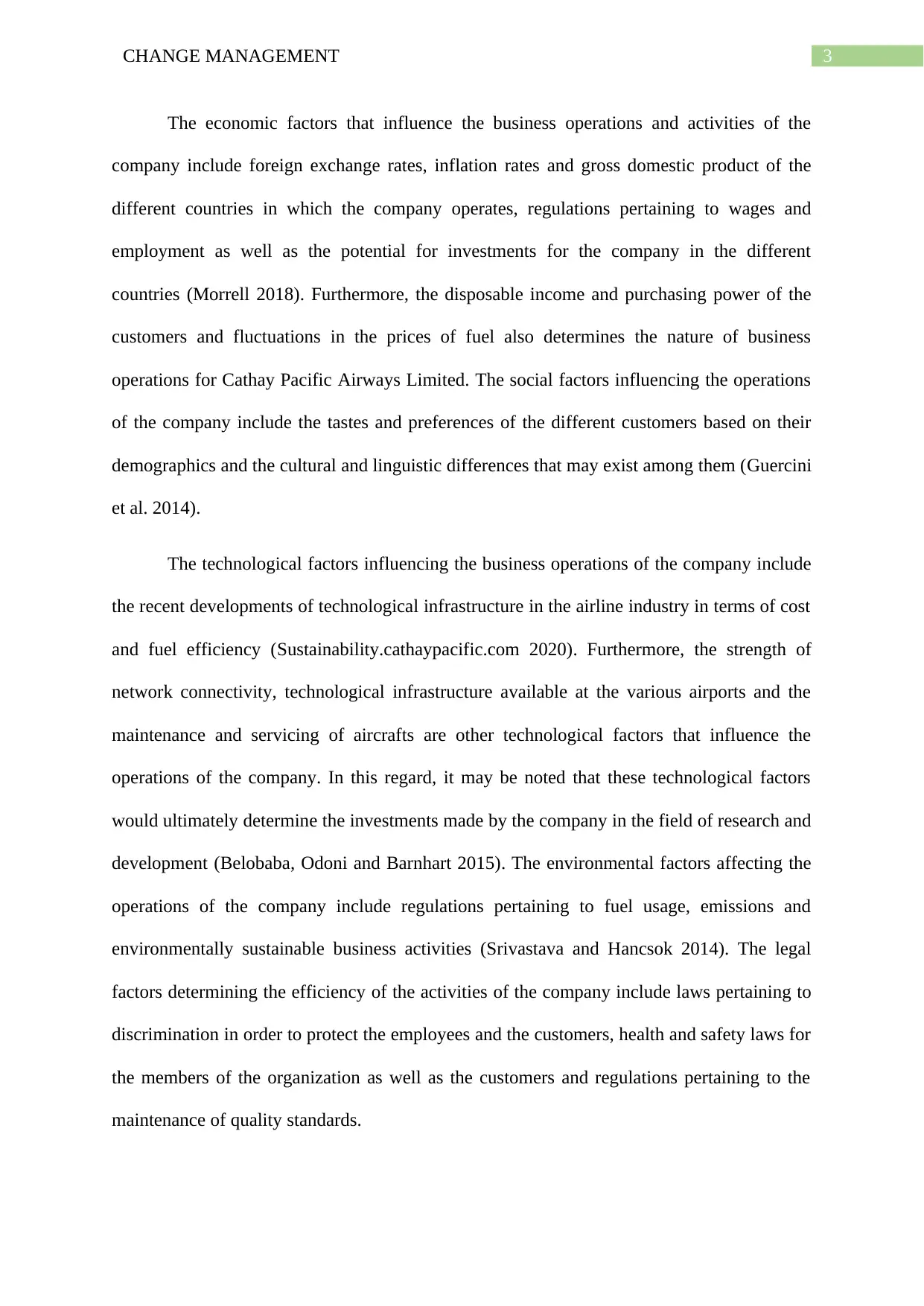
3CHANGE MANAGEMENT
The economic factors that influence the business operations and activities of the
company include foreign exchange rates, inflation rates and gross domestic product of the
different countries in which the company operates, regulations pertaining to wages and
employment as well as the potential for investments for the company in the different
countries (Morrell 2018). Furthermore, the disposable income and purchasing power of the
customers and fluctuations in the prices of fuel also determines the nature of business
operations for Cathay Pacific Airways Limited. The social factors influencing the operations
of the company include the tastes and preferences of the different customers based on their
demographics and the cultural and linguistic differences that may exist among them (Guercini
et al. 2014).
The technological factors influencing the business operations of the company include
the recent developments of technological infrastructure in the airline industry in terms of cost
and fuel efficiency (Sustainability.cathaypacific.com 2020). Furthermore, the strength of
network connectivity, technological infrastructure available at the various airports and the
maintenance and servicing of aircrafts are other technological factors that influence the
operations of the company. In this regard, it may be noted that these technological factors
would ultimately determine the investments made by the company in the field of research and
development (Belobaba, Odoni and Barnhart 2015). The environmental factors affecting the
operations of the company include regulations pertaining to fuel usage, emissions and
environmentally sustainable business activities (Srivastava and Hancsok 2014). The legal
factors determining the efficiency of the activities of the company include laws pertaining to
discrimination in order to protect the employees and the customers, health and safety laws for
the members of the organization as well as the customers and regulations pertaining to the
maintenance of quality standards.
The economic factors that influence the business operations and activities of the
company include foreign exchange rates, inflation rates and gross domestic product of the
different countries in which the company operates, regulations pertaining to wages and
employment as well as the potential for investments for the company in the different
countries (Morrell 2018). Furthermore, the disposable income and purchasing power of the
customers and fluctuations in the prices of fuel also determines the nature of business
operations for Cathay Pacific Airways Limited. The social factors influencing the operations
of the company include the tastes and preferences of the different customers based on their
demographics and the cultural and linguistic differences that may exist among them (Guercini
et al. 2014).
The technological factors influencing the business operations of the company include
the recent developments of technological infrastructure in the airline industry in terms of cost
and fuel efficiency (Sustainability.cathaypacific.com 2020). Furthermore, the strength of
network connectivity, technological infrastructure available at the various airports and the
maintenance and servicing of aircrafts are other technological factors that influence the
operations of the company. In this regard, it may be noted that these technological factors
would ultimately determine the investments made by the company in the field of research and
development (Belobaba, Odoni and Barnhart 2015). The environmental factors affecting the
operations of the company include regulations pertaining to fuel usage, emissions and
environmentally sustainable business activities (Srivastava and Hancsok 2014). The legal
factors determining the efficiency of the activities of the company include laws pertaining to
discrimination in order to protect the employees and the customers, health and safety laws for
the members of the organization as well as the customers and regulations pertaining to the
maintenance of quality standards.
Paraphrase This Document
Need a fresh take? Get an instant paraphrase of this document with our AI Paraphraser
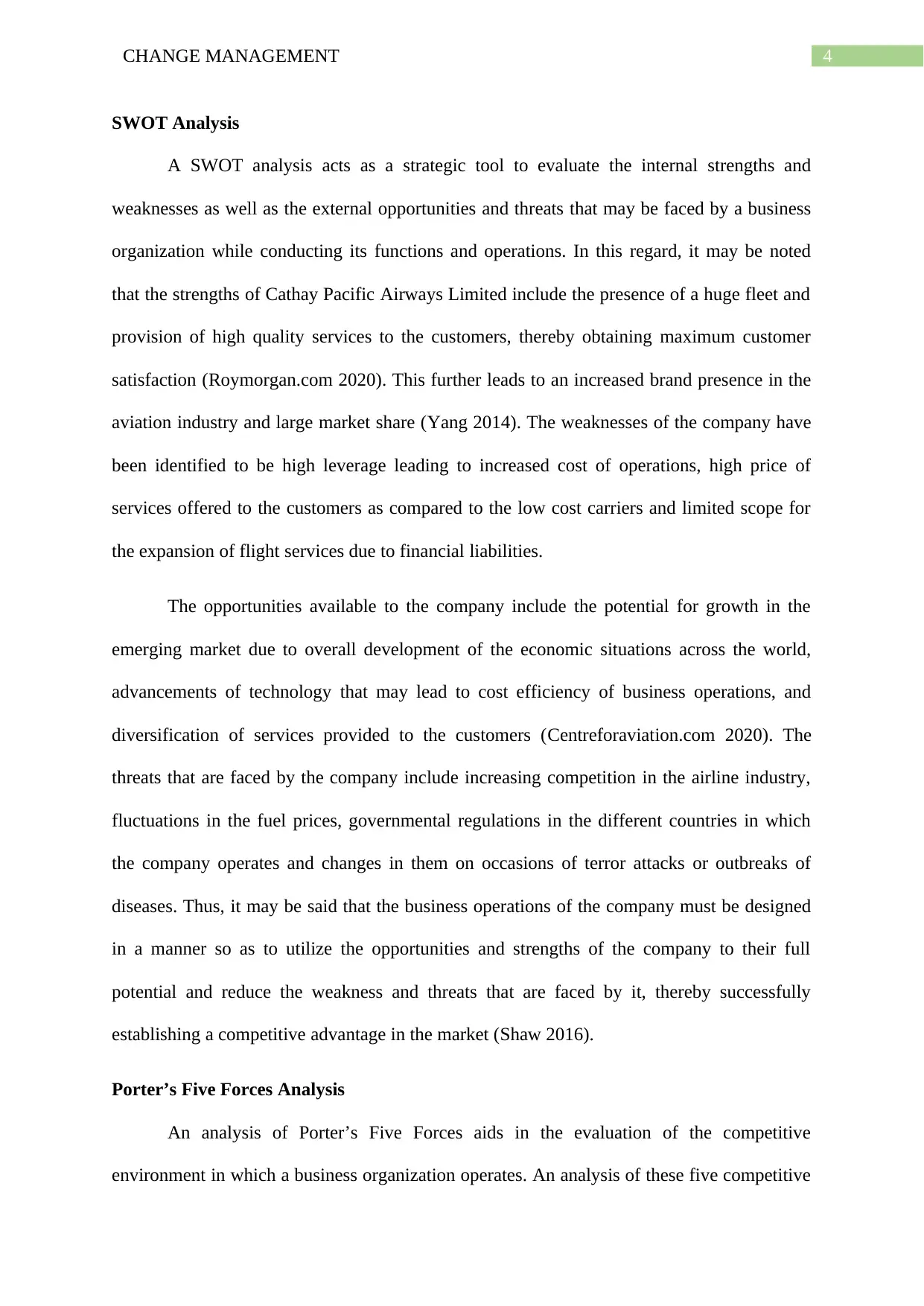
4CHANGE MANAGEMENT
SWOT Analysis
A SWOT analysis acts as a strategic tool to evaluate the internal strengths and
weaknesses as well as the external opportunities and threats that may be faced by a business
organization while conducting its functions and operations. In this regard, it may be noted
that the strengths of Cathay Pacific Airways Limited include the presence of a huge fleet and
provision of high quality services to the customers, thereby obtaining maximum customer
satisfaction (Roymorgan.com 2020). This further leads to an increased brand presence in the
aviation industry and large market share (Yang 2014). The weaknesses of the company have
been identified to be high leverage leading to increased cost of operations, high price of
services offered to the customers as compared to the low cost carriers and limited scope for
the expansion of flight services due to financial liabilities.
The opportunities available to the company include the potential for growth in the
emerging market due to overall development of the economic situations across the world,
advancements of technology that may lead to cost efficiency of business operations, and
diversification of services provided to the customers (Centreforaviation.com 2020). The
threats that are faced by the company include increasing competition in the airline industry,
fluctuations in the fuel prices, governmental regulations in the different countries in which
the company operates and changes in them on occasions of terror attacks or outbreaks of
diseases. Thus, it may be said that the business operations of the company must be designed
in a manner so as to utilize the opportunities and strengths of the company to their full
potential and reduce the weakness and threats that are faced by it, thereby successfully
establishing a competitive advantage in the market (Shaw 2016).
Porter’s Five Forces Analysis
An analysis of Porter’s Five Forces aids in the evaluation of the competitive
environment in which a business organization operates. An analysis of these five competitive
SWOT Analysis
A SWOT analysis acts as a strategic tool to evaluate the internal strengths and
weaknesses as well as the external opportunities and threats that may be faced by a business
organization while conducting its functions and operations. In this regard, it may be noted
that the strengths of Cathay Pacific Airways Limited include the presence of a huge fleet and
provision of high quality services to the customers, thereby obtaining maximum customer
satisfaction (Roymorgan.com 2020). This further leads to an increased brand presence in the
aviation industry and large market share (Yang 2014). The weaknesses of the company have
been identified to be high leverage leading to increased cost of operations, high price of
services offered to the customers as compared to the low cost carriers and limited scope for
the expansion of flight services due to financial liabilities.
The opportunities available to the company include the potential for growth in the
emerging market due to overall development of the economic situations across the world,
advancements of technology that may lead to cost efficiency of business operations, and
diversification of services provided to the customers (Centreforaviation.com 2020). The
threats that are faced by the company include increasing competition in the airline industry,
fluctuations in the fuel prices, governmental regulations in the different countries in which
the company operates and changes in them on occasions of terror attacks or outbreaks of
diseases. Thus, it may be said that the business operations of the company must be designed
in a manner so as to utilize the opportunities and strengths of the company to their full
potential and reduce the weakness and threats that are faced by it, thereby successfully
establishing a competitive advantage in the market (Shaw 2016).
Porter’s Five Forces Analysis
An analysis of Porter’s Five Forces aids in the evaluation of the competitive
environment in which a business organization operates. An analysis of these five competitive

5CHANGE MANAGEMENT
forces with respect to Cathay Pacific Airways Limited thereby determines the nature and
scope of their business operations so as to induce growth and obtain a competitive advantage
in the market. The threat of new entrants faced by the company is low as the capital
investment requirements in the airline industry is substantially high, thereby making it
difficult for new entrants to successfully set up their business (Snider and Williams 2015).
Furthermore, since the obtaining of economies of scale is difficult to achieve in the airline
industry, the large scale producers have a significant cost advantage. The company also faces
low threat from substitutes, as the flight services are usually preferred by customers across
the world due to its fast and easily accessible nature. The company faces low threat from the
bargaining power of the suppliers because of the presence of a large number of suppliers in
the market (Ramón-Rodríguez, Moreno-Izquierdo and Perles-Ribes 2011). In terms of the
bargaining power of the buyers, the company faces moderate threat due to the presence of a
large number of competitors in the market for the customers to choose. However, this force
does not affect the business operations of the company in a significant manner. In terms of
competitive rivalry, the company faces a high amount of threat. It is so because the airline
industry has developed exponentially in the recent years, thereby facilitating the companies
operating within it to develop efficient strategies in order to obtain a competitive advantage in
the market (Wensveen 2010). Furthermore, the presence of a number of low cost carriers in
the airline industry of Southeast Asia proves to be a major threat to the business operations of
Cathay Pacific Airways Limited.
Force Field Analysis
Force field analysis is a tool developed by Kurt Lewin and entails the evaluation of
the various factors that either drive or resist changes within the scope of a business
organization. In the case that the forces supporting or favoring the change are stronger than
the forces opposing or resisting it, the change management process can be conducted within
forces with respect to Cathay Pacific Airways Limited thereby determines the nature and
scope of their business operations so as to induce growth and obtain a competitive advantage
in the market. The threat of new entrants faced by the company is low as the capital
investment requirements in the airline industry is substantially high, thereby making it
difficult for new entrants to successfully set up their business (Snider and Williams 2015).
Furthermore, since the obtaining of economies of scale is difficult to achieve in the airline
industry, the large scale producers have a significant cost advantage. The company also faces
low threat from substitutes, as the flight services are usually preferred by customers across
the world due to its fast and easily accessible nature. The company faces low threat from the
bargaining power of the suppliers because of the presence of a large number of suppliers in
the market (Ramón-Rodríguez, Moreno-Izquierdo and Perles-Ribes 2011). In terms of the
bargaining power of the buyers, the company faces moderate threat due to the presence of a
large number of competitors in the market for the customers to choose. However, this force
does not affect the business operations of the company in a significant manner. In terms of
competitive rivalry, the company faces a high amount of threat. It is so because the airline
industry has developed exponentially in the recent years, thereby facilitating the companies
operating within it to develop efficient strategies in order to obtain a competitive advantage in
the market (Wensveen 2010). Furthermore, the presence of a number of low cost carriers in
the airline industry of Southeast Asia proves to be a major threat to the business operations of
Cathay Pacific Airways Limited.
Force Field Analysis
Force field analysis is a tool developed by Kurt Lewin and entails the evaluation of
the various factors that either drive or resist changes within the scope of a business
organization. In the case that the forces supporting or favoring the change are stronger than
the forces opposing or resisting it, the change management process can be conducted within
⊘ This is a preview!⊘
Do you want full access?
Subscribe today to unlock all pages.

Trusted by 1+ million students worldwide
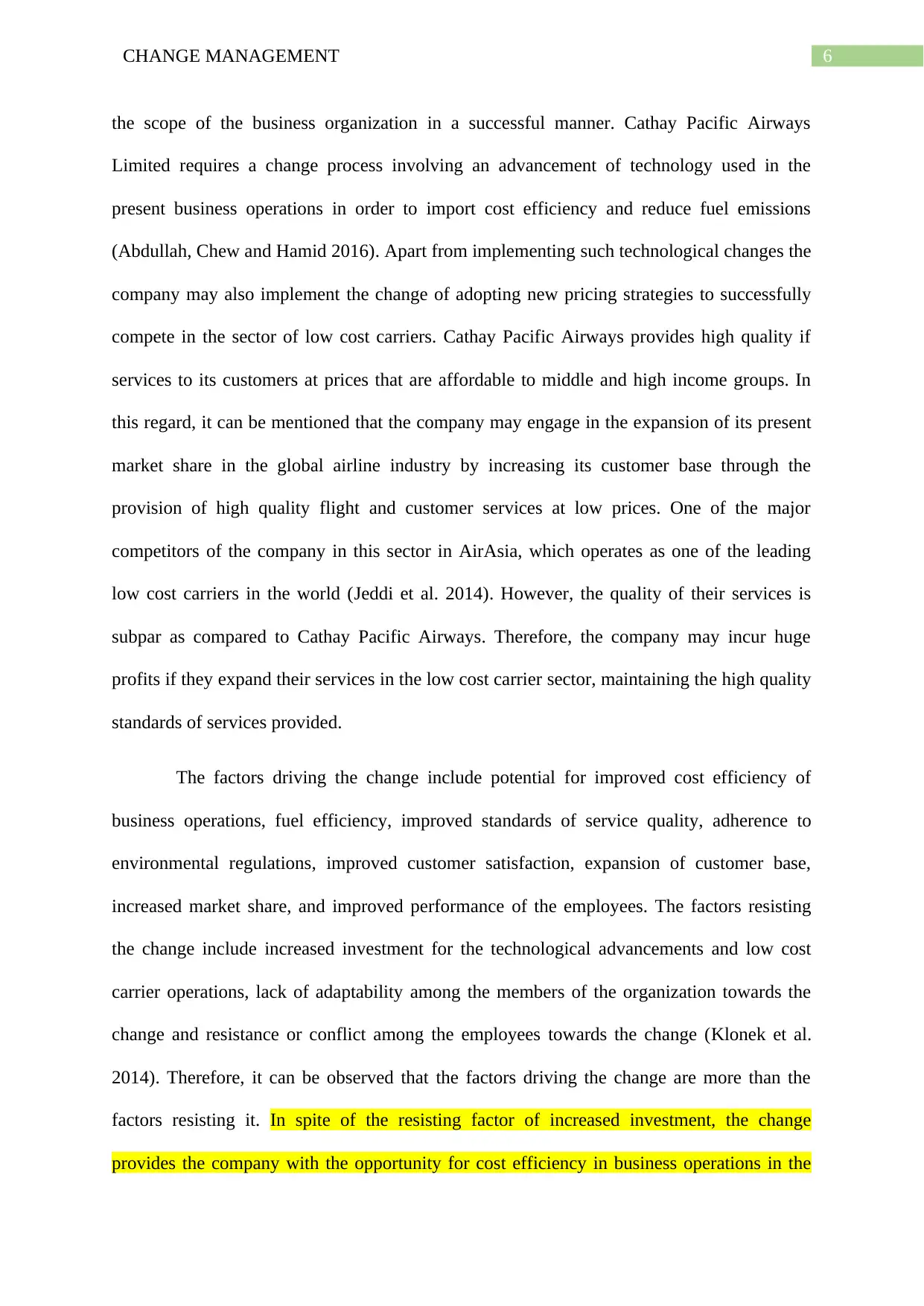
6CHANGE MANAGEMENT
the scope of the business organization in a successful manner. Cathay Pacific Airways
Limited requires a change process involving an advancement of technology used in the
present business operations in order to import cost efficiency and reduce fuel emissions
(Abdullah, Chew and Hamid 2016). Apart from implementing such technological changes the
company may also implement the change of adopting new pricing strategies to successfully
compete in the sector of low cost carriers. Cathay Pacific Airways provides high quality if
services to its customers at prices that are affordable to middle and high income groups. In
this regard, it can be mentioned that the company may engage in the expansion of its present
market share in the global airline industry by increasing its customer base through the
provision of high quality flight and customer services at low prices. One of the major
competitors of the company in this sector in AirAsia, which operates as one of the leading
low cost carriers in the world (Jeddi et al. 2014). However, the quality of their services is
subpar as compared to Cathay Pacific Airways. Therefore, the company may incur huge
profits if they expand their services in the low cost carrier sector, maintaining the high quality
standards of services provided.
The factors driving the change include potential for improved cost efficiency of
business operations, fuel efficiency, improved standards of service quality, adherence to
environmental regulations, improved customer satisfaction, expansion of customer base,
increased market share, and improved performance of the employees. The factors resisting
the change include increased investment for the technological advancements and low cost
carrier operations, lack of adaptability among the members of the organization towards the
change and resistance or conflict among the employees towards the change (Klonek et al.
2014). Therefore, it can be observed that the factors driving the change are more than the
factors resisting it. In spite of the resisting factor of increased investment, the change
provides the company with the opportunity for cost efficiency in business operations in the
the scope of the business organization in a successful manner. Cathay Pacific Airways
Limited requires a change process involving an advancement of technology used in the
present business operations in order to import cost efficiency and reduce fuel emissions
(Abdullah, Chew and Hamid 2016). Apart from implementing such technological changes the
company may also implement the change of adopting new pricing strategies to successfully
compete in the sector of low cost carriers. Cathay Pacific Airways provides high quality if
services to its customers at prices that are affordable to middle and high income groups. In
this regard, it can be mentioned that the company may engage in the expansion of its present
market share in the global airline industry by increasing its customer base through the
provision of high quality flight and customer services at low prices. One of the major
competitors of the company in this sector in AirAsia, which operates as one of the leading
low cost carriers in the world (Jeddi et al. 2014). However, the quality of their services is
subpar as compared to Cathay Pacific Airways. Therefore, the company may incur huge
profits if they expand their services in the low cost carrier sector, maintaining the high quality
standards of services provided.
The factors driving the change include potential for improved cost efficiency of
business operations, fuel efficiency, improved standards of service quality, adherence to
environmental regulations, improved customer satisfaction, expansion of customer base,
increased market share, and improved performance of the employees. The factors resisting
the change include increased investment for the technological advancements and low cost
carrier operations, lack of adaptability among the members of the organization towards the
change and resistance or conflict among the employees towards the change (Klonek et al.
2014). Therefore, it can be observed that the factors driving the change are more than the
factors resisting it. In spite of the resisting factor of increased investment, the change
provides the company with the opportunity for cost efficiency in business operations in the
Paraphrase This Document
Need a fresh take? Get an instant paraphrase of this document with our AI Paraphraser
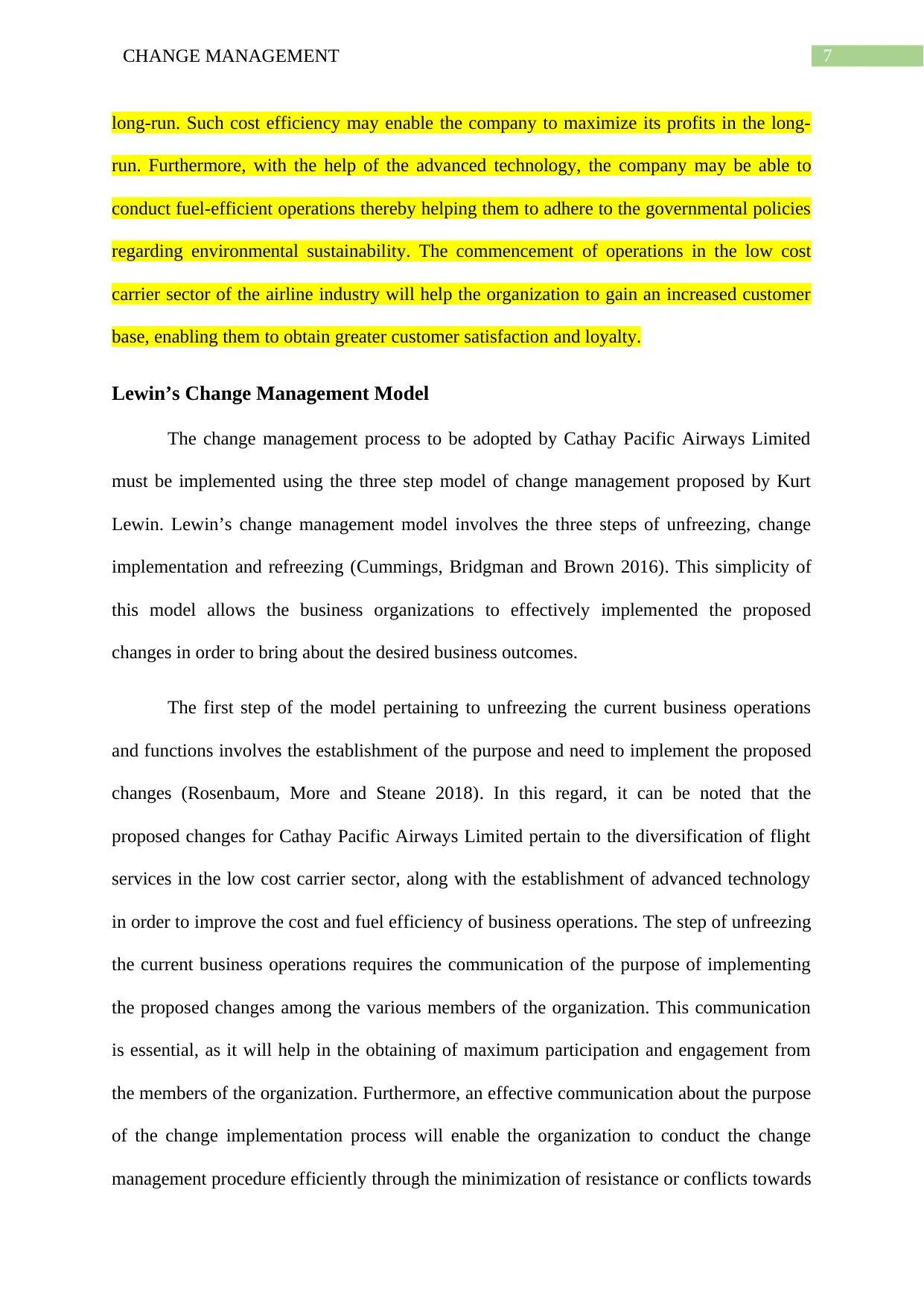
7CHANGE MANAGEMENT
long-run. Such cost efficiency may enable the company to maximize its profits in the long-
run. Furthermore, with the help of the advanced technology, the company may be able to
conduct fuel-efficient operations thereby helping them to adhere to the governmental policies
regarding environmental sustainability. The commencement of operations in the low cost
carrier sector of the airline industry will help the organization to gain an increased customer
base, enabling them to obtain greater customer satisfaction and loyalty.
Lewin’s Change Management Model
The change management process to be adopted by Cathay Pacific Airways Limited
must be implemented using the three step model of change management proposed by Kurt
Lewin. Lewin’s change management model involves the three steps of unfreezing, change
implementation and refreezing (Cummings, Bridgman and Brown 2016). This simplicity of
this model allows the business organizations to effectively implemented the proposed
changes in order to bring about the desired business outcomes.
The first step of the model pertaining to unfreezing the current business operations
and functions involves the establishment of the purpose and need to implement the proposed
changes (Rosenbaum, More and Steane 2018). In this regard, it can be noted that the
proposed changes for Cathay Pacific Airways Limited pertain to the diversification of flight
services in the low cost carrier sector, along with the establishment of advanced technology
in order to improve the cost and fuel efficiency of business operations. The step of unfreezing
the current business operations requires the communication of the purpose of implementing
the proposed changes among the various members of the organization. This communication
is essential, as it will help in the obtaining of maximum participation and engagement from
the members of the organization. Furthermore, an effective communication about the purpose
of the change implementation process will enable the organization to conduct the change
management procedure efficiently through the minimization of resistance or conflicts towards
long-run. Such cost efficiency may enable the company to maximize its profits in the long-
run. Furthermore, with the help of the advanced technology, the company may be able to
conduct fuel-efficient operations thereby helping them to adhere to the governmental policies
regarding environmental sustainability. The commencement of operations in the low cost
carrier sector of the airline industry will help the organization to gain an increased customer
base, enabling them to obtain greater customer satisfaction and loyalty.
Lewin’s Change Management Model
The change management process to be adopted by Cathay Pacific Airways Limited
must be implemented using the three step model of change management proposed by Kurt
Lewin. Lewin’s change management model involves the three steps of unfreezing, change
implementation and refreezing (Cummings, Bridgman and Brown 2016). This simplicity of
this model allows the business organizations to effectively implemented the proposed
changes in order to bring about the desired business outcomes.
The first step of the model pertaining to unfreezing the current business operations
and functions involves the establishment of the purpose and need to implement the proposed
changes (Rosenbaum, More and Steane 2018). In this regard, it can be noted that the
proposed changes for Cathay Pacific Airways Limited pertain to the diversification of flight
services in the low cost carrier sector, along with the establishment of advanced technology
in order to improve the cost and fuel efficiency of business operations. The step of unfreezing
the current business operations requires the communication of the purpose of implementing
the proposed changes among the various members of the organization. This communication
is essential, as it will help in the obtaining of maximum participation and engagement from
the members of the organization. Furthermore, an effective communication about the purpose
of the change implementation process will enable the organization to conduct the change
management procedure efficiently through the minimization of resistance or conflicts towards
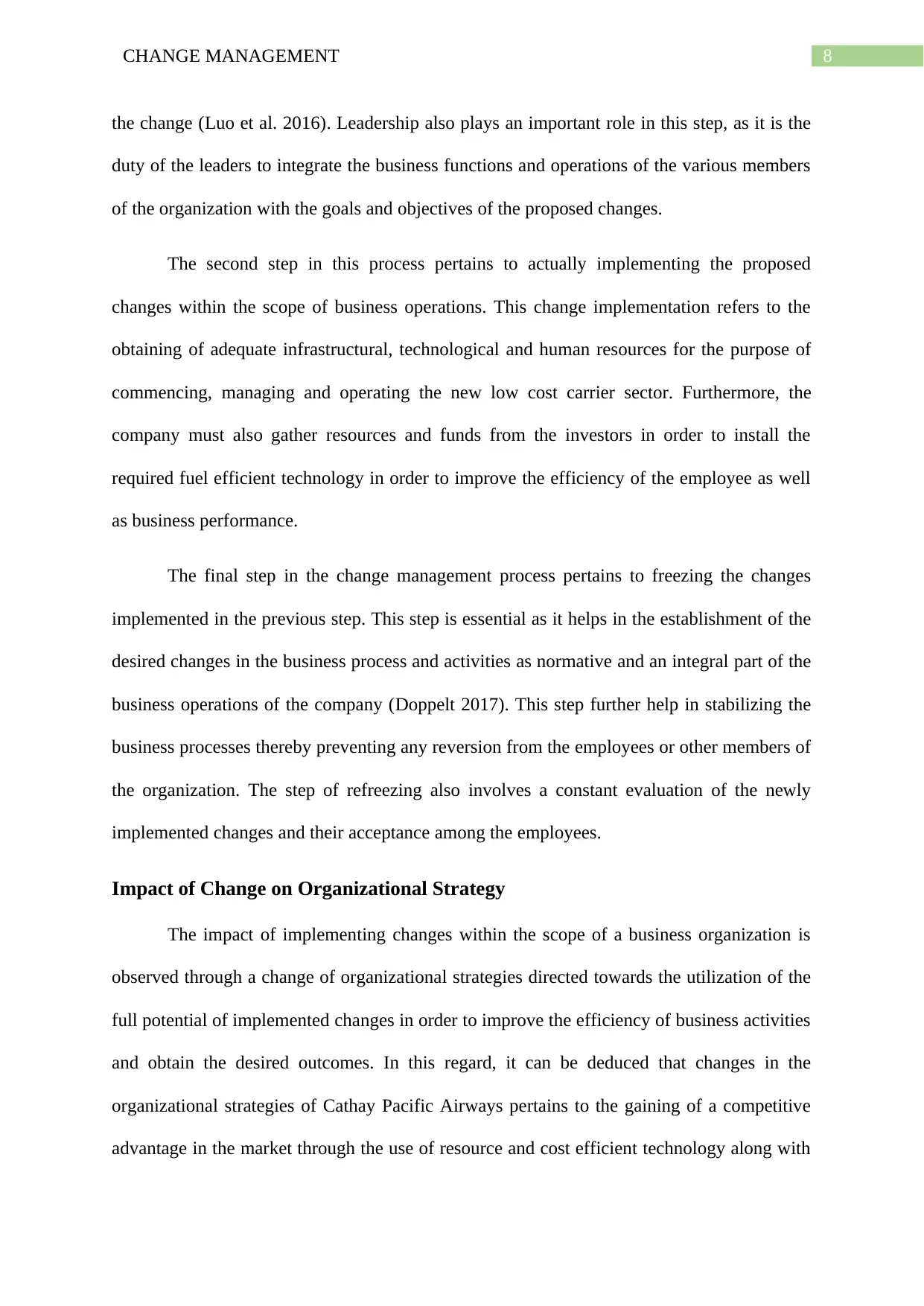
8CHANGE MANAGEMENT
the change (Luo et al. 2016). Leadership also plays an important role in this step, as it is the
duty of the leaders to integrate the business functions and operations of the various members
of the organization with the goals and objectives of the proposed changes.
The second step in this process pertains to actually implementing the proposed
changes within the scope of business operations. This change implementation refers to the
obtaining of adequate infrastructural, technological and human resources for the purpose of
commencing, managing and operating the new low cost carrier sector. Furthermore, the
company must also gather resources and funds from the investors in order to install the
required fuel efficient technology in order to improve the efficiency of the employee as well
as business performance.
The final step in the change management process pertains to freezing the changes
implemented in the previous step. This step is essential as it helps in the establishment of the
desired changes in the business process and activities as normative and an integral part of the
business operations of the company (Doppelt 2017). This step further help in stabilizing the
business processes thereby preventing any reversion from the employees or other members of
the organization. The step of refreezing also involves a constant evaluation of the newly
implemented changes and their acceptance among the employees.
Impact of Change on Organizational Strategy
The impact of implementing changes within the scope of a business organization is
observed through a change of organizational strategies directed towards the utilization of the
full potential of implemented changes in order to improve the efficiency of business activities
and obtain the desired outcomes. In this regard, it can be deduced that changes in the
organizational strategies of Cathay Pacific Airways pertains to the gaining of a competitive
advantage in the market through the use of resource and cost efficient technology along with
the change (Luo et al. 2016). Leadership also plays an important role in this step, as it is the
duty of the leaders to integrate the business functions and operations of the various members
of the organization with the goals and objectives of the proposed changes.
The second step in this process pertains to actually implementing the proposed
changes within the scope of business operations. This change implementation refers to the
obtaining of adequate infrastructural, technological and human resources for the purpose of
commencing, managing and operating the new low cost carrier sector. Furthermore, the
company must also gather resources and funds from the investors in order to install the
required fuel efficient technology in order to improve the efficiency of the employee as well
as business performance.
The final step in the change management process pertains to freezing the changes
implemented in the previous step. This step is essential as it helps in the establishment of the
desired changes in the business process and activities as normative and an integral part of the
business operations of the company (Doppelt 2017). This step further help in stabilizing the
business processes thereby preventing any reversion from the employees or other members of
the organization. The step of refreezing also involves a constant evaluation of the newly
implemented changes and their acceptance among the employees.
Impact of Change on Organizational Strategy
The impact of implementing changes within the scope of a business organization is
observed through a change of organizational strategies directed towards the utilization of the
full potential of implemented changes in order to improve the efficiency of business activities
and obtain the desired outcomes. In this regard, it can be deduced that changes in the
organizational strategies of Cathay Pacific Airways pertains to the gaining of a competitive
advantage in the market through the use of resource and cost efficient technology along with
⊘ This is a preview!⊘
Do you want full access?
Subscribe today to unlock all pages.

Trusted by 1+ million students worldwide
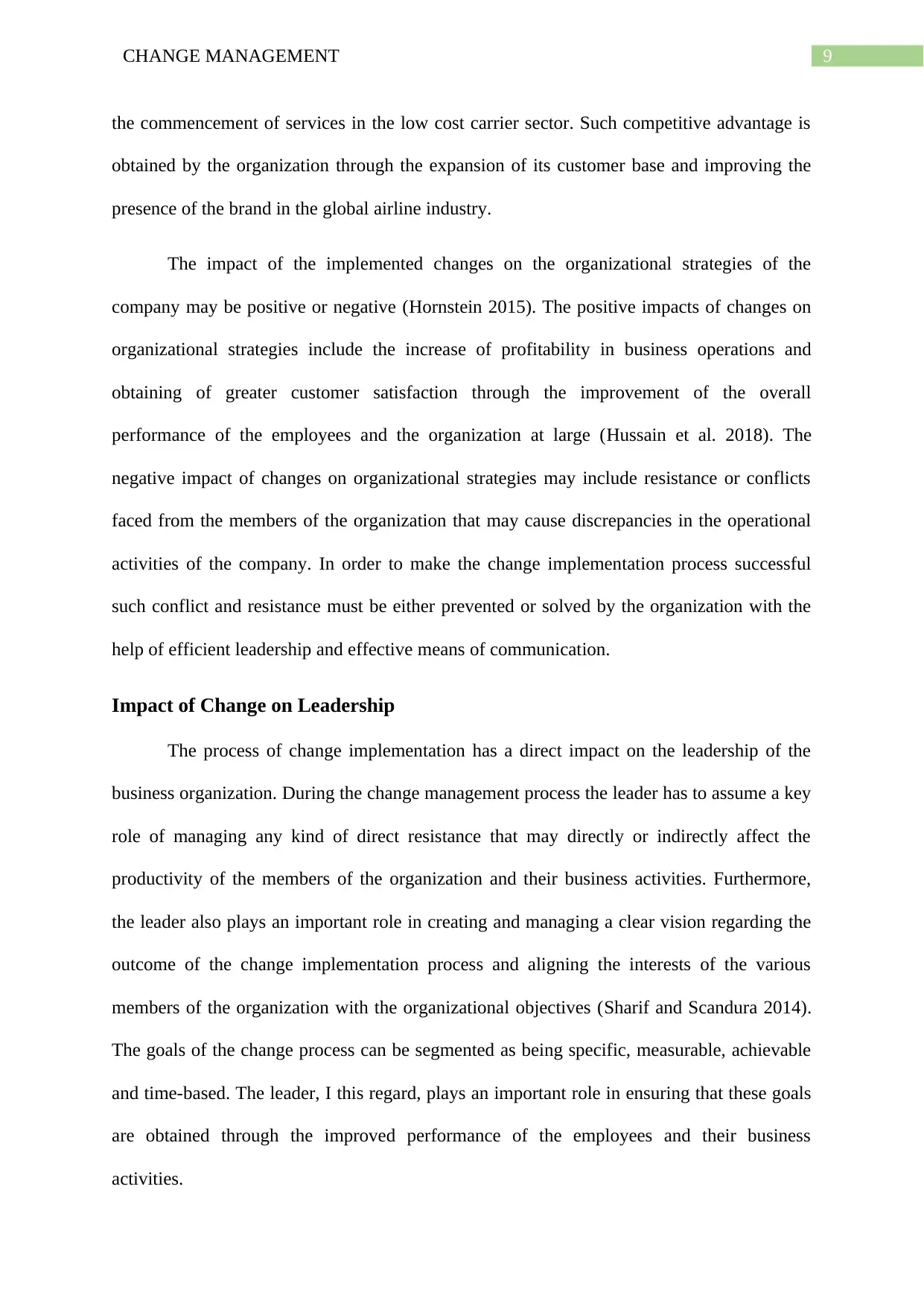
9CHANGE MANAGEMENT
the commencement of services in the low cost carrier sector. Such competitive advantage is
obtained by the organization through the expansion of its customer base and improving the
presence of the brand in the global airline industry.
The impact of the implemented changes on the organizational strategies of the
company may be positive or negative (Hornstein 2015). The positive impacts of changes on
organizational strategies include the increase of profitability in business operations and
obtaining of greater customer satisfaction through the improvement of the overall
performance of the employees and the organization at large (Hussain et al. 2018). The
negative impact of changes on organizational strategies may include resistance or conflicts
faced from the members of the organization that may cause discrepancies in the operational
activities of the company. In order to make the change implementation process successful
such conflict and resistance must be either prevented or solved by the organization with the
help of efficient leadership and effective means of communication.
Impact of Change on Leadership
The process of change implementation has a direct impact on the leadership of the
business organization. During the change management process the leader has to assume a key
role of managing any kind of direct resistance that may directly or indirectly affect the
productivity of the members of the organization and their business activities. Furthermore,
the leader also plays an important role in creating and managing a clear vision regarding the
outcome of the change implementation process and aligning the interests of the various
members of the organization with the organizational objectives (Sharif and Scandura 2014).
The goals of the change process can be segmented as being specific, measurable, achievable
and time-based. The leader, I this regard, plays an important role in ensuring that these goals
are obtained through the improved performance of the employees and their business
activities.
the commencement of services in the low cost carrier sector. Such competitive advantage is
obtained by the organization through the expansion of its customer base and improving the
presence of the brand in the global airline industry.
The impact of the implemented changes on the organizational strategies of the
company may be positive or negative (Hornstein 2015). The positive impacts of changes on
organizational strategies include the increase of profitability in business operations and
obtaining of greater customer satisfaction through the improvement of the overall
performance of the employees and the organization at large (Hussain et al. 2018). The
negative impact of changes on organizational strategies may include resistance or conflicts
faced from the members of the organization that may cause discrepancies in the operational
activities of the company. In order to make the change implementation process successful
such conflict and resistance must be either prevented or solved by the organization with the
help of efficient leadership and effective means of communication.
Impact of Change on Leadership
The process of change implementation has a direct impact on the leadership of the
business organization. During the change management process the leader has to assume a key
role of managing any kind of direct resistance that may directly or indirectly affect the
productivity of the members of the organization and their business activities. Furthermore,
the leader also plays an important role in creating and managing a clear vision regarding the
outcome of the change implementation process and aligning the interests of the various
members of the organization with the organizational objectives (Sharif and Scandura 2014).
The goals of the change process can be segmented as being specific, measurable, achievable
and time-based. The leader, I this regard, plays an important role in ensuring that these goals
are obtained through the improved performance of the employees and their business
activities.
Paraphrase This Document
Need a fresh take? Get an instant paraphrase of this document with our AI Paraphraser

10CHANGE MANAGEMENT
Effectiveness of Leadership Approaches in Change Management
The conception of transformational change involves changes made in the culture of
business organizations through the transformations in the strategies and business operations
conducted (Schein 2015). Leadership skills and competencies play an important role in
determining the efficiency of the newly transformed organizational culture and business
processes. The most suitable form of leadership in business organizations undergoing change
management processes in situational leadership.
Situational leadership encompasses the utilization of the skills and knowledge of the
leaders of a business organization for the purpose of adjusting their activities according to the
needs of the organization (Thompson and Glasø 2015). During the change management
process, the organization may be encountered by several challenging situations that were not
predicted beforehand. In order to be able to efficiently tackle such situations, the leaders of
the organization must adopt a situational style that allows them to analyze each situation and
weigh the opportunities and threats that may be faced by the organization under those
circumstances (McCleskey 2014). Situational leadership thereby allows the leaders to utilize
the opportunities available to the company under each circumstance efficiently and prevent
the company from getting affected by the challenges or threats severely. In the case of Cathay
Pacific Airways, the adoption of situational style of leadership may be deemed as
advantageous as it will help the organization to effectively tackle the challenges that may
arise from the change management process and obtain the desired business outcomes.
Certain example regarding the effectiveness of situational leadership can be cited,
which depict how this form of leadership aids the leads to efficiently utilize the opportunities
available to them in spite of challenging situations in the business scenario. The former Chief
Executive Officer of Barclays plc, an investment company in the United Kingdom, helped the
organization in managing the challenging situations of a government bailout and credit
Effectiveness of Leadership Approaches in Change Management
The conception of transformational change involves changes made in the culture of
business organizations through the transformations in the strategies and business operations
conducted (Schein 2015). Leadership skills and competencies play an important role in
determining the efficiency of the newly transformed organizational culture and business
processes. The most suitable form of leadership in business organizations undergoing change
management processes in situational leadership.
Situational leadership encompasses the utilization of the skills and knowledge of the
leaders of a business organization for the purpose of adjusting their activities according to the
needs of the organization (Thompson and Glasø 2015). During the change management
process, the organization may be encountered by several challenging situations that were not
predicted beforehand. In order to be able to efficiently tackle such situations, the leaders of
the organization must adopt a situational style that allows them to analyze each situation and
weigh the opportunities and threats that may be faced by the organization under those
circumstances (McCleskey 2014). Situational leadership thereby allows the leaders to utilize
the opportunities available to the company under each circumstance efficiently and prevent
the company from getting affected by the challenges or threats severely. In the case of Cathay
Pacific Airways, the adoption of situational style of leadership may be deemed as
advantageous as it will help the organization to effectively tackle the challenges that may
arise from the change management process and obtain the desired business outcomes.
Certain example regarding the effectiveness of situational leadership can be cited,
which depict how this form of leadership aids the leads to efficiently utilize the opportunities
available to them in spite of challenging situations in the business scenario. The former Chief
Executive Officer of Barclays plc, an investment company in the United Kingdom, helped the
organization in managing the challenging situations of a government bailout and credit
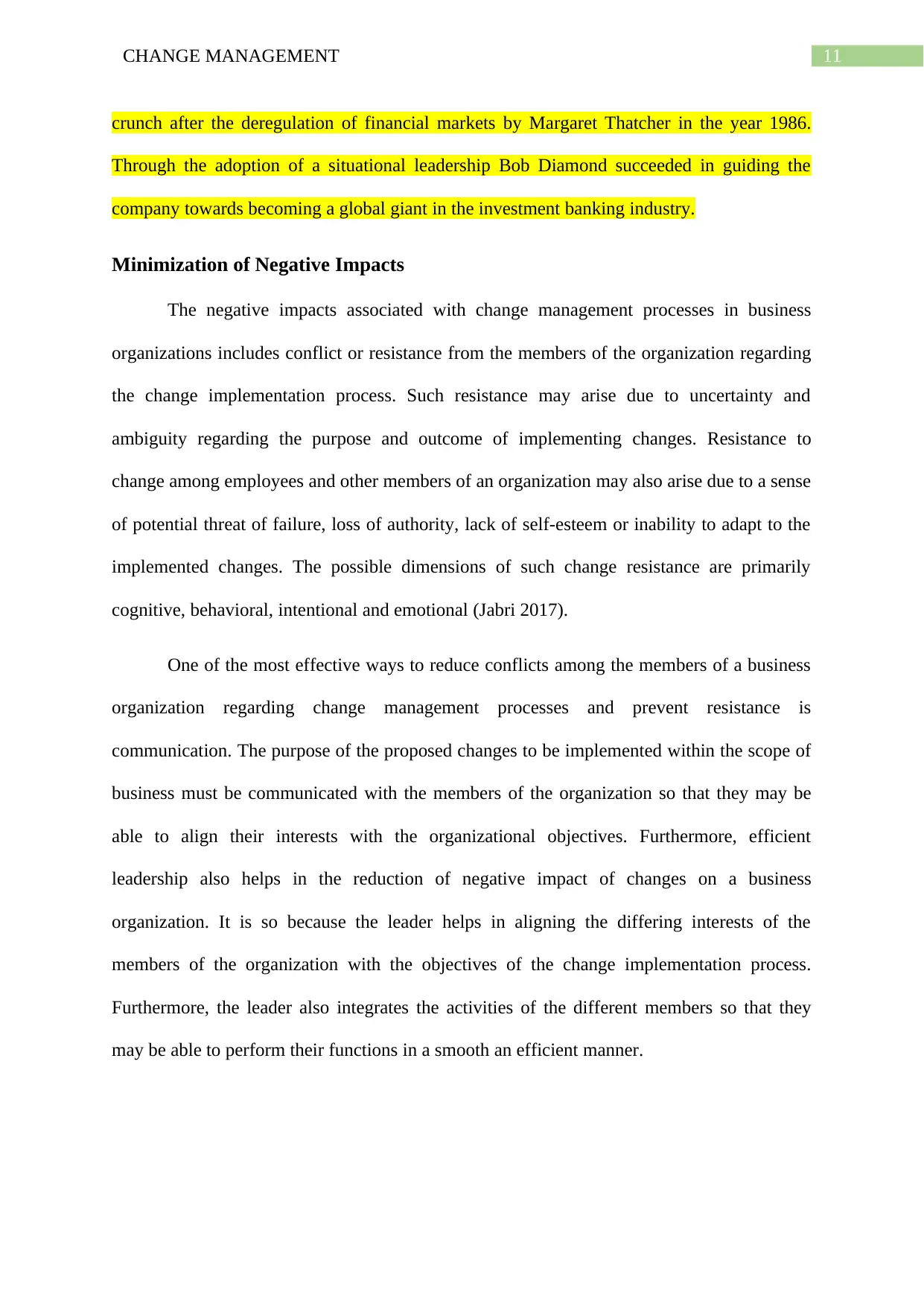
11CHANGE MANAGEMENT
crunch after the deregulation of financial markets by Margaret Thatcher in the year 1986.
Through the adoption of a situational leadership Bob Diamond succeeded in guiding the
company towards becoming a global giant in the investment banking industry.
Minimization of Negative Impacts
The negative impacts associated with change management processes in business
organizations includes conflict or resistance from the members of the organization regarding
the change implementation process. Such resistance may arise due to uncertainty and
ambiguity regarding the purpose and outcome of implementing changes. Resistance to
change among employees and other members of an organization may also arise due to a sense
of potential threat of failure, loss of authority, lack of self-esteem or inability to adapt to the
implemented changes. The possible dimensions of such change resistance are primarily
cognitive, behavioral, intentional and emotional (Jabri 2017).
One of the most effective ways to reduce conflicts among the members of a business
organization regarding change management processes and prevent resistance is
communication. The purpose of the proposed changes to be implemented within the scope of
business must be communicated with the members of the organization so that they may be
able to align their interests with the organizational objectives. Furthermore, efficient
leadership also helps in the reduction of negative impact of changes on a business
organization. It is so because the leader helps in aligning the differing interests of the
members of the organization with the objectives of the change implementation process.
Furthermore, the leader also integrates the activities of the different members so that they
may be able to perform their functions in a smooth an efficient manner.
crunch after the deregulation of financial markets by Margaret Thatcher in the year 1986.
Through the adoption of a situational leadership Bob Diamond succeeded in guiding the
company towards becoming a global giant in the investment banking industry.
Minimization of Negative Impacts
The negative impacts associated with change management processes in business
organizations includes conflict or resistance from the members of the organization regarding
the change implementation process. Such resistance may arise due to uncertainty and
ambiguity regarding the purpose and outcome of implementing changes. Resistance to
change among employees and other members of an organization may also arise due to a sense
of potential threat of failure, loss of authority, lack of self-esteem or inability to adapt to the
implemented changes. The possible dimensions of such change resistance are primarily
cognitive, behavioral, intentional and emotional (Jabri 2017).
One of the most effective ways to reduce conflicts among the members of a business
organization regarding change management processes and prevent resistance is
communication. The purpose of the proposed changes to be implemented within the scope of
business must be communicated with the members of the organization so that they may be
able to align their interests with the organizational objectives. Furthermore, efficient
leadership also helps in the reduction of negative impact of changes on a business
organization. It is so because the leader helps in aligning the differing interests of the
members of the organization with the objectives of the change implementation process.
Furthermore, the leader also integrates the activities of the different members so that they
may be able to perform their functions in a smooth an efficient manner.
⊘ This is a preview!⊘
Do you want full access?
Subscribe today to unlock all pages.

Trusted by 1+ million students worldwide
1 out of 20
Related Documents
Your All-in-One AI-Powered Toolkit for Academic Success.
+13062052269
info@desklib.com
Available 24*7 on WhatsApp / Email
![[object Object]](/_next/static/media/star-bottom.7253800d.svg)
Unlock your academic potential
Copyright © 2020–2025 A2Z Services. All Rights Reserved. Developed and managed by ZUCOL.





